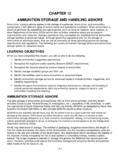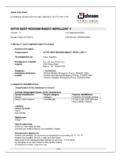Transcription of INDG230 - STORING AND HANDLING AMMONIUM NITRATE
1 STORING AND HANDLING AMMONIUM NITRATE INTRODUCTION The Health and Safety at Work etc Act 1974 imposes general duties to ensure that workers and others are protected against risks to their health and safety from work activities. This leaflet has therefore been produced to help duty holders to ensure the safe storage and HANDLING of AMMONIUM NITRATE at, for example, harbours, merchant stores and manufacturers' premises. The main use of AMMONIUM NITRATE is as a fertiliser, marketed either as prills (small spheres) or granules. The different types of AMMONIUM NITRATE fertiliser are described at the end of this leaflet. This leaflet does not apply to the following, although many of the general principles may still be relevant: transport; AMMONIUM NITRATE classified as an explosive and assigned to Class 1 of the UN classification system. This would be subject to controls under the Explosives Act 1875; storage of AMMONIUM NITRATE fertilisers in quantities below 1 tonne, provided good housekeeping standards and sensible separation from incompatible materials are maintained.
2 For fertilisers that contain 28% or less nitrogen (see the label or other hazard information) this limit is raised to 50 tonnes. PROPERTIES AND HAZARDS AMMONIUM NITRATE has a melting point of 1700C and decomposes above 2100C. It is not in itself combustible but, as it is an oxidising agent, it can assist other materials to burn, even if air is excluded. AMMONIUM NITRATE will not explode due to the friction and impact found in normal HANDLING , but it can be detonated under heat and confinement or severe shock. For example, in a fire, pools of molten AMMONIUM NITRATE may be formed and if the molten mass becomes confined (eg in drains, pipes, plant or machinery) it could explode, particularly if it becomes contaminated. In a fire, all types of AMMONIUM NITRATE may melt and decompose with the release of toxic fumes (mainly oxides of nitrogen) which may be yellow or brown.
3 Most types do not continue to decompose once the fire has been extinguished. However, when some types of AMMONIUM NITRATE fertilisers (cigar burners) are heated they undergo a smouldering (self-sustaining) decomposition that can spread throughout the mass to give substantial toxic fumes, even when the initial heat source is removed. 2 The risk of fire or explosion is greatly increased if AMMONIUM NITRATE is mixed with combustible or incompatible materials, such as powdered metals, alkali metals, urea, chromium or copper salts, organic and carbonaceous materials, sulphur, nitrites, alkalis, acids, chlorates and reducing agents (consult data sheets to establish if a substance has reducing properties). PRECAUTIONS The precautions described here are primarily designed to minimise the risk of explosion, however they can also reduce the risks associated with oxidising properties and the release of toxic fumes in a fire.
4 Fertilisers that contain 28% or less nitrogen (see the label or data sheets for the percentage of nitrogen present) do not normally present an explosion hazard and therefore, to identify the precautions required, AMMONIUM NITRATE based fertilisers can be divided into two groups: Fertilisers that contain more than 28% nitrogen. Most of these are straight AMMONIUM NITRATE types, although they include a small number of compound fertilisers. Fertilisers that contain 28% or less nitrogen. Compound fertilisers form the major proportion of this group. The straight nitrogen types are usually a mixture of AMMONIUM NITRATE with limestone or similar inert materials. AMMONIUM NITRATE AND AMMONIUM NITRATE FERTILISERS This section concerns AMMONIUM NITRATE and AMMONIUM NITRATE fertilisers that contain more than 28% nitrogen. The risk of an explosion is increased by a combination of the following: heating AMMONIUM NITRATE (eg in a fire); contamination; serious confinement (eg in drains or enclosed parts of equipment).
5 To minimise the risk of explosion it is therefore important to take precautions against each of these situations. 3 The Fertilisers Regulations 1991, as amended, require all straight AMMONIUM NITRATE fertiliser with more than 28% nitrogen, sold for final use in the UK, to be packaged and meet certain quality criteria, minimising the risk of contamination and therefore explosion. Storage areas AMMONIUM NITRATE should normally be stored in single storey, dedicated, well-ventilated buildings that are constructed from materials that will not burn, such as concrete, bricks or steel. Clean the store before it is used for AMMONIUM NITRATE . However, in some circumstances, such as where the stores are located near to densely populated areas, it may be better to store AMMONIUM NITRATE outside, provided it is in a secure area away from combustible materials and sources of contamination.
6 Such outdoor storage can remove or reduce the risk of, for example, fires due to electric lights and other equipment. However, if AMMONIUM NITRATE is stored outdoors it may be necessary to consider methods to prevent it deteriorating due to sunlight or water (eg covering it with sheets or shrink-wrapping and ensuring that water can run away from the storage area). Avoid drains, channels or pits where molten AMMONIUM NITRATE from a fire could become confined. Where the presence of drains, etc is unavoidable, they should be protected so that molten AMMONIUM NITRATE cannot run into them. Locate storage away from possible sources of heat, fire or explosion, such as oil storage, gas pipelines, timber yards, flammable liquids, flammable solids and combustible materials. Arson and faulty or damaged electrical equipment are major risk factors for warehouse fires, so prevent unauthorised access to the store.
7 Ensure regular inspection and maintenance of electrical equipment and fittings. Damage from animals can be limited by implementing a pest control system. Stacks Self-confinement of straight AMMONIUM NITRATE in large stacks can increase the risk of a detonation of the whole stack in a fire, so limit stacks to a maximum of 300 tonnes. This limit may be raised at purpose-built stores at manufacturing sites, provided that the other recommendations in this leaflet are followed and the material complies with the quality specification in the Fertilisers Regulations 1991. Keep straight AMMONIUM NITRATE of relatively low density (ie non fertiliser grade below 900 kg/m3 - see the label or other documents) 4 to stacks of approximately 2 m high and 3 m wide, but again this limit may be raised at purpose-built stores. To help prevent fires and other heat sources from affecting stored AMMONIUM NITRATE , and to allow access to stacks in an emergency, leave a space of at least 1 m between stacks and between the stack and the walls, roof or any electric lights or heating pipes.
8 Check the height of doors, beams and electrical equipment in relation to that of any lifting equipment used, such as fork-lift trucks. Do not allow AMMONIUM NITRATE , including when molten in a fire, to come into contact with materials such as flammable liquids, powdered metals, acids, chlorates, nitrates, zinc, copper and its salts, oils, grease, gas cylinders and chemicals of incompatible or unknown properties. Do not store AMMONIUM NITRATE in the same building as such materials. When it is absolutely necessary to store urea and AMMONIUM NITRATE products in the same building, keep them in such a manner that they cannot mix with each other in any likely accident. This can be achieved by keeping the materials in separate bays which have walls that extend at least 1 m beyond the limit of storage of each material . Do not store AMMONIUM NITRATE that contains more than 28% nitrogen in the same stack as other products.
9 On farms, separate AMMONIUM NITRATE fertiliser from hay, straw, grain, feedstuffs, or other combustible materials by a suitable fire break, such as a distance of at least 5 m or a barrier of inert material of at least m (eg one pallet) width. General precautions For ease of movement and stability of the stacks keep 50 kg bags palletised. To prevent spillage and contamination make sure that the bags have been completely sealed on filling, are made of a material that is impermeable to water or oil, and are strong enough to withstand damage during normal storage, HANDLING and conveyance. Paper packaging alone is therefore unsuitable. It is recommended that 50 kg bags have microvents to avoid ballooning and consequent instability in stacks. Where wooden pallets are used check that they are not damaged or significantly contaminated. Do not store unused pallets in, or against the walls of, the store because of the increased risk of fire affecting the AMMONIUM NITRATE .
10 Where it is necessary to keep the pallets in the store, separate them from the AMMONIUM NITRATE by a suitable fire break or partition. 5 Prohibit smoking in all storage areas and display prominent NO SMOKING notices. Keep vehicles, fork-lift trucks and mechanical shovels clean and well maintained to prevent AMMONIUM NITRATE coming into contact with fuel, oil or grease. It is recommended that mobile equipment is fitted with suitable fire extinguishers of adequate capacity to deal with a fire on the vehicle. Do not leave such equipment running while unattended or store it in the storage area unless separated from the AMMONIUM NITRATE by a suitable fire break, preferably in a clearly marked, dedicated area. Housekeeping The following precautions are also essential: Store filled bags and intermediate bulk containers (IBCs) in stable stacks.














